New Study Exonerates Urban Pests Like Rats as One-of-a-Kind Disease Reservoirs
An international research team led by scientists at Georgetown University has found that city wildlife might pose less of a threat for future pandemics than once thought.
In a study published in Nature Ecology and Evolution, researchers set out to understand whether animals adapted to living in cities tend to have different viruses. The study was led by Greg Albery, a postdoctoral fellow in the Department of Biology at Georgetown University College of Arts and Sciences.
The COVID-19 pandemic has sparked substantial interest in where future outbreaks are at the highest risk of emerging. Scientists have long suspected that cities might be a hotspot for outbreak risk, thanks to species like rats that make their home alongside us. For Washington, DC, those problems are now close to home: in March 2022, the U.S. Centers for Disease Control and Prevention announced that the growing rat problem allowed a respiratory virus called Seoul hantavirus to infect two people in 2018.
Albery set out to study whether species like rats might play host to a greater number of these pathogens. In the study, Albery and colleagues examined the pathogens hosted by nearly 3,000 mammal species, and found that urban-adapted animals could host roughly ten times as many kinds of disease. However, they found that pattern was partly a problem of sampling bias: the same species were nearly 100 times better studied in the scientific literature.
“There are plenty of reasons to expect urban animals to host more diseases, ranging from their food to their immune systems to their close proximity to humans,” said Albery. “We found that urban species do indeed host more diseases than non-urban species, but the reasons for this appear to be largely associated with the way we study the ecology of disease. We’ve looked more at animals in our cities, so we’ve found more of their parasites—and we’ve started to hit diminishing returns.”
To Albery’s surprise, after adjusting for sampling bias, the team found that city-living species don’t seem to host more human-infective viruses more often than their rural counterparts. “Stunningly, although urban-adapted species have 10 times as many parasites, more than 100 times as many studies have been published on them. When you correct for this bias, they don’t have more human pathogens than expected – meaning that our perception of their novel disease risk has been overinflated by our sampling process.”
The study’s findings might exonerate city wildlife from being “hyper-reservoirs” of infectious disease. However, Albery cautions, that doesn’t mean cities are disease-free.
“This probably means that urban animals aren’t hiding as many important novel pathogens as we might think – those pathogens that might cause the next ‘Disease X’,” said Albery. “But they are still incredibly important carriers of many pathogens that we do know about. Rats, raccoons, and rabbits are still good at coexisting alongside us, and they still spread a lot of diseases to humans living in urban areas.”
Colin Carlson, an author on the study and an assistant research professor at the Center for Global Health Science and Security at Georgetown University Medical Center, said that the study highlights the value of scientific data. The researchers used a database called The Global Virome in One Network, created by the Verena Consortium (viralemergence.org), an open science network founded by Carlson and Albery.
“If we take the time to build better datasets, and look more closely at the patterns in them, we might keep overturning long-standing assumptions about who’s at risk from emerging diseases and why,” said Carlson.
The study concludes that future research should go beyond how many pathogens any given animal has, and start to explore how city living shapes the prevalence and transmission of those diseases. Understanding those phenomena may require researchers to collect much more data, particularly from new places; almost all of the disease data in the study came from the United States and Europe.
“What this really accentuates is that we need to design more evenly distributed, more equitable sampling regimes if we want to find novel pathogens of humans; sampling needs to be more focused in wild areas of the world, but also in urban areas in less well-studied places,” said Albery. “Not only will this help us to find the new ones, but will improve surveillance of the old ones, and will ultimately help to address ages-old geographic biases in ecology.”
